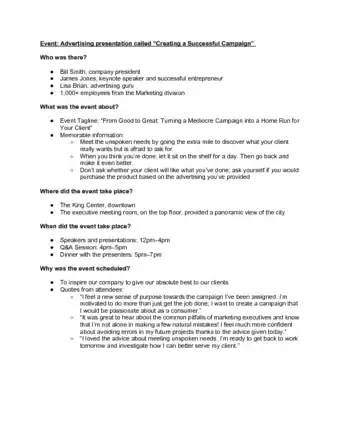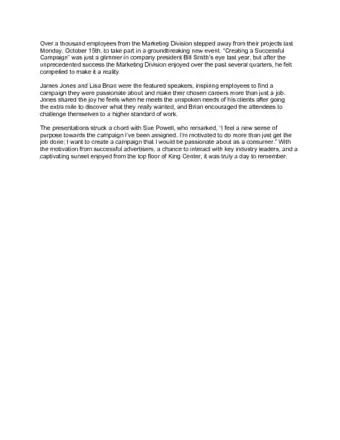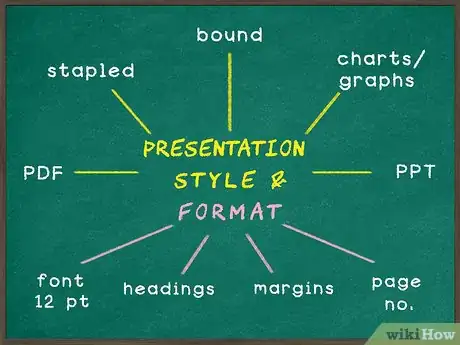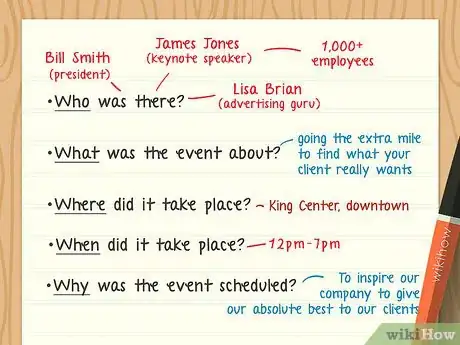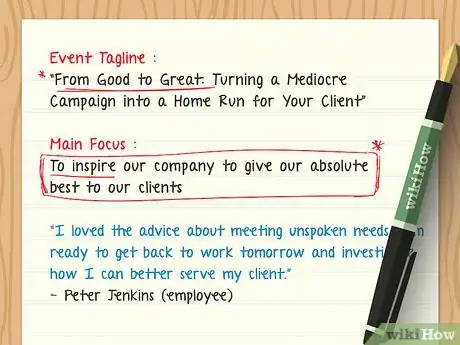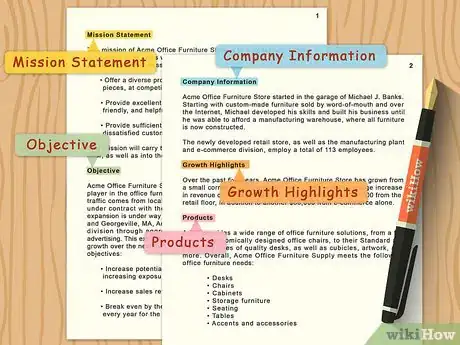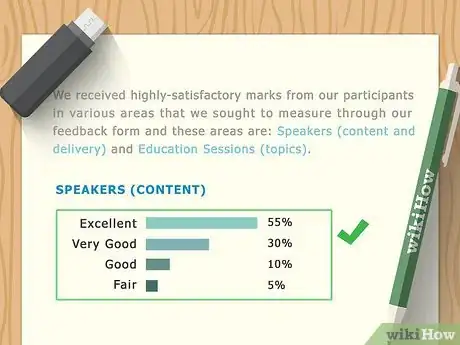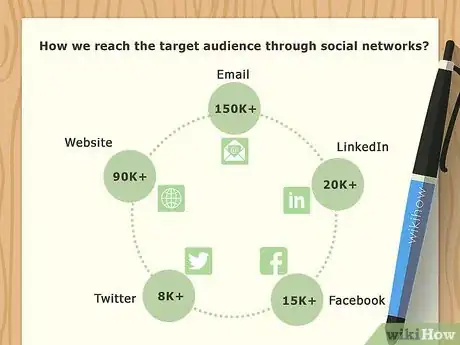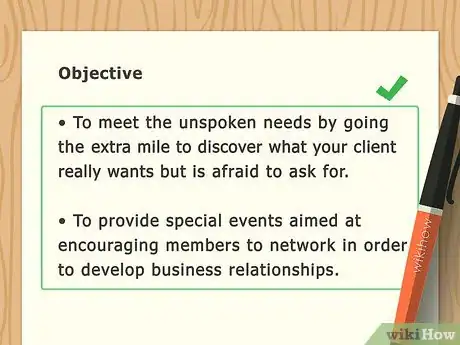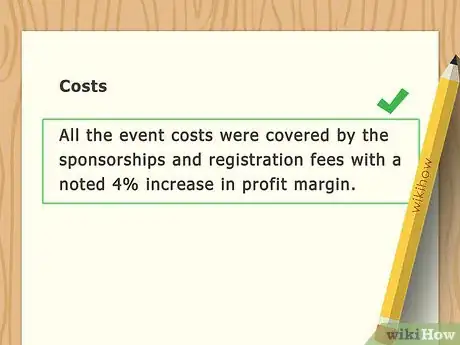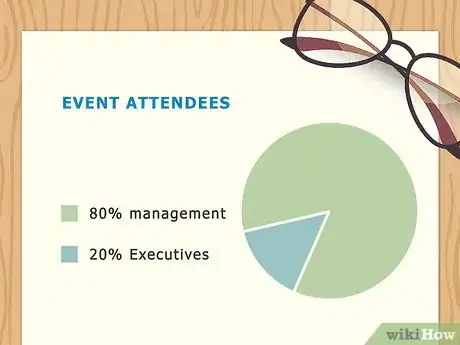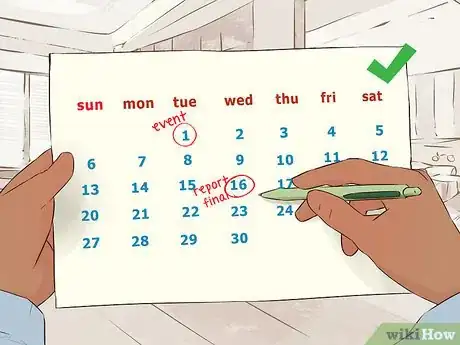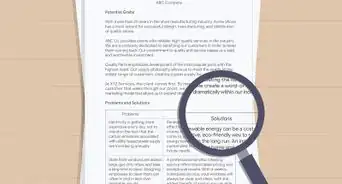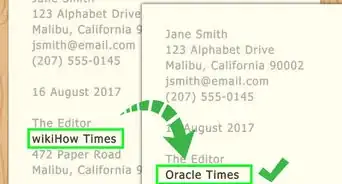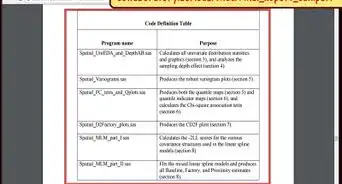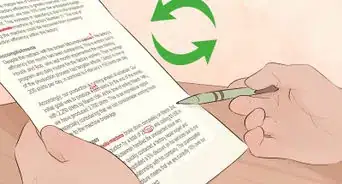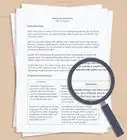wikiHow is a “wiki,” similar to Wikipedia, which means that many of our articles are co-written by multiple authors. To create this article, 31 people, some anonymous, worked to edit and improve it over time.
This article has been viewed 1,270,840 times.
Learn more...
Maybe you need to write an event report or essay to determine whether an event was successful by comparing its results against its objectives. It’s an important way that people or companies who’ve held events can determine whether they should make changes. There are ways you can ensure your event report is more successful. This matters if you're thinking of holding another event!
Steps
Event Report Help
Organizing Your Event Report
-
1Determine the presentation style and format for each audience. Event reports can be bound, stapled, emailed PDFs, PowerPoint presentations, and so on.
- Make sure the event report is organized into clear sections. You want to determine how the results of the event compared to the objectives for it. Summarize the main outcomes of the event.
- Tailor the event report for the needs and interests of each sponsor and audience. Consider the objectives of the sponsors. To some degree, sponsors are the key audience for an event report. They want to know whether it was worth sponsoring the event. So consider what they will want to know and what their hot buttons are.
- Tailor the event report to also meet the specific needs of the uniqueness of the event and sponsors. Don’t write a color-by-numbers report. Other audiences for the event report include senior executives and financial managers.
-
2Create a process to track information you will need throughout the event. You don’t want to have to rely on your memory.
- Tracking key information before, during, and after the event will allow for a more specific, and ultimately more effective, report. It will also allow you to compile it all in a timelier fashion.
- Consider data collection to be continuous, using multiple people if necessary (including possible interns) to collect data. The bottom line is that you should not wait to create the report until the end of the event.
Advertisement -
3Boil it down to the key points. One problem with some event reports is that they do little more than regurgitate the agenda or focus on feel-good, booster-ish statements. Don’t do that. Instead, highlight the key points with a clear, analytical eye.
- Pick out some of the event highlights to discuss in detail. Consider which three things worked best, and which three points were most surprising.[1]
- Avoid packing the article with mundane details, such as the luncheon menu or a detailed summary of the entire presentation of the keynote speaker. You want to pull out the things that mattered.
Putting the Right Content in Your Report
-
1Write an executive summary. The event report should include an executive summary that is a concise version of the more detailed full report. Think of the executive summary as being like an introduction. [2]
- You could create two reports – an executive summary designed for people who have some interest in the event’s outcome, and a more detailed fuller report for people actually involved in setting up or sponsoring the event.
- In the executive summary, you want to boil down and focus on the key objects and results. The executive summary should be brief – just one or two pages. It should summarize the key elements delivered by the event, and it should include a brief interpretation of the data.
-
2Include visuals in your event report. It’s often more effective to offer a chart illustrating statistical trends, instead of just presenting readers with a bunch of numbers.
- If the event included a new product, you could present a photo of it. Photos of the actual event could help illustrate the event report. Try to get photos of sponsors’ exposure on the site to document it for the report. Again, this is a task that can’t wait until after the event.
- Samples, reproductions, and other on-site examples are good to include. Report the number of people who received sponsor coupons, etc. Document both on-site and off-site exposure generated by the event, in the media, to the audience, for sponsors.
-
3Document all advertising and media exposure. You want to assess the media that was generated compared to the objectives outlined.
- Focus on print ads and articles in which sponsors’ names and ads appeared, in addition to gathering circulation figures and advertising rates.
- Document television advertising, public service announcements, ratings and rate card values, and news coverage.
- Don’t forget to document radio, rate card ads, values for ads and promotions, audited reports, and so on.
-
4Include a statement of the event’s objectives. It’s really important to link the event’s objectives with its results, so make sure that you include a reminder of what the event’s original mission was and which goals were set.
- You might include a listing of your event program. You should also discuss who the key participants were in the event at some point. Keep these sections brief, though.
- Make sure to spend the most time listing and discussing the specific key outcomes of the event and matching them to the outcomes that were listed. Be realistic, and don't try to sugarcoat things that didn't work.
-
5Include financial information in the event report. It’s important to provide a detailed discussion of the event’s budget and what was actually spent (or potentially brought in). Make sure to include a comparison of budgeted expenditures versus actual ones, as well as highlighting things that worked well and areas needing improvement.[3]
- You should detail all costs, including marketing and promotional activities, staff expenses, and sponsorship costs. It’s a good idea to include a detailed budget. Financial managers and senior executives will want to see evidence that backs up conclusions.
- Include an accounting of revenue, such as fees, sponsorships, and exhibits. But make sure that you compare revenues to revenue projections. Compared to what? That's a good question to ask.
-
6Include statistics that will be relevant to the readers. You don’t want a report that’s packed with only feel-good information. The number of people who attended is one statistic you should include. It’s a good idea to provide data that has a measurable aspect to it.
- Other pertinent statistics and data can include the number of sales leads generated and the number of visitors to a specific booth. Providing data gives more credibility to the event report. Provide participant/attendee information. Include demographics, attendance figures, and audience research results (such as purchasing habits).
- Report on the number of people who respond to sponsors’ campaigns, as well as donations to charitable organizations. Document the economic impact and employee participation.
-
7Have a qualitative element that contextualizes the data. Your report should include some statistics, but you also need human quotes to provide contextual feedback.
- Gather quotes and feedback from participants and event team members so that the assessment of the event's successes and failures doesn’t come only from the event report’s author. It will be seen as more credible.
- Consider including third-party research as well. Placing a value on media exposure is one example of something a third party could research.
- Assess the space and set ups. You should spend some time assessing the effectiveness of the location and the set ups from the vantage point of others. Discuss how space was used by the conference, event, etc.
Finalizing Your Event Report
-
1Be timely with the report. Try to write and publish the report pretty quickly after the event. Make sure you schedule it on your calendar to make sure that happens. Some people suggest issuing an event report within 30 days, but others say you should do it within a few days.[4]
- Whatever the deadline is, make sure that you meet it. Perhaps you are writing the event report for an agency that has been commissioned by a specific client. Pay attention to all requests.
- The bottom line is that your audience will expect both a thorough and a timely report. So take the time to be thorough and get it right, but don’t wait so long it seems dated.
-
2Proofread your event report. Make sure that your event report contains proper grammar and avoid spelling, punctuation, and other proofing errors.
- Make sure that your answers contain depth. A good rule of thumb is the writing technique “show, don’t tell.” That means it’s a good idea to provide some specific examples to back up more general points that are made in the report.
- Don’t forget your audience, and make sure that your writing sounds formal and professional. An event report is not a casual document; it’s an essential document to determine whether the event was worth it, so it needs to be authoritative.
Community Q&A
-
QuestionHow can I go about writing a report of a training that just ended in my office?
 Community AnswerYou could start by writing about the organization and what the training was aimed at. Then you could continue with the participants and the activities that was conducted for the same. Lastly, you could conclude on a positive note about how it would benefit the next phase of the process.
Community AnswerYou could start by writing about the organization and what the training was aimed at. Then you could continue with the participants and the activities that was conducted for the same. Lastly, you could conclude on a positive note about how it would benefit the next phase of the process. -
QuestionHow can I write a report after an exhibition that our company participated in?
 Community AnswerYou would follow the same procedures, but add specific details about the exhibition that you participated in while writing the report.
Community AnswerYou would follow the same procedures, but add specific details about the exhibition that you participated in while writing the report. -
QuestionHow can I write a report about a community meeting in the school?
 Community AnswerFirst of all, jot down the reason/s for the community meeting. Then, note who the meeting affected, what was talked about in the meeting, what problem/s needed to be solved, if they were solved, and how they were solved. Wrap it up noting any further action that needs to be taken in the future and/or at additional meetings.
Community AnswerFirst of all, jot down the reason/s for the community meeting. Then, note who the meeting affected, what was talked about in the meeting, what problem/s needed to be solved, if they were solved, and how they were solved. Wrap it up noting any further action that needs to be taken in the future and/or at additional meetings.
Things You'll Need
- A digital camera
- A note-pad
References
- ↑ http://www.nonprofitmarketingguide.com/blog/2007/04/20/how-to-write-an-event-summary-for-your-newsletter/
- ↑ https://hbswk.hbs.edu/archive/crafting-a-powerful-executive-summary
- ↑ https://www.forbes.com/sites/davelavinsky/2013/12/03/business-plan-outline-23-point-checklist-for-success/?sh=4c79bd9f5275
- ↑ http://hawthornlandings.org/2013/02/15/how-to-writing-an-excellent-post-event-wrap-up-report/
About This Article
To write an event report, start by writing a 1-2 page executive summary, which is an introduction that provides a concise version of your more detailed report. Then, explain the who, what, where, when, and why of the event in the body of your report. You'll also want to include a statement about the event’s objectives, as well as information about any relevant advertising, media exposure, or financial information. You can also use charts and graphs to convey information in a visually appealing and easy-to-understand way. To learn how to best match your event report style and format to your audience, read on!
